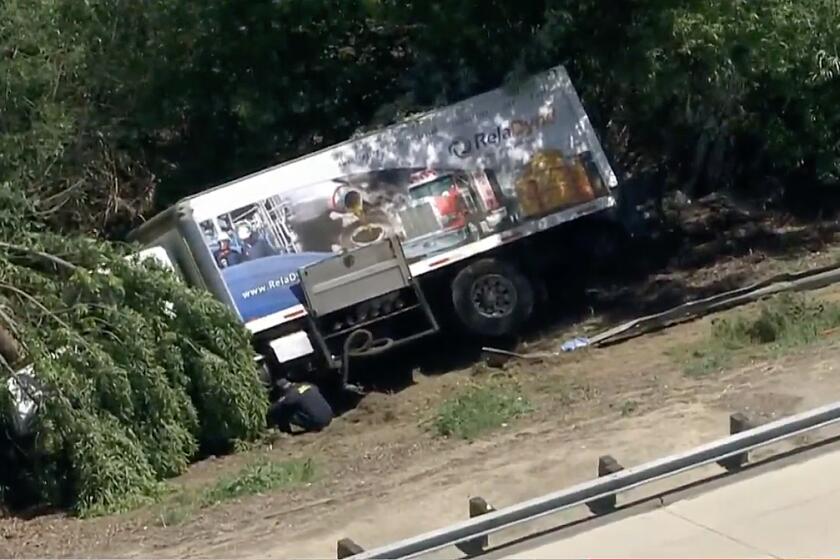‘Battle of Palmdale’: Sound, Fury and 1 Lost Plane
In the midst of the Cold War, when Nike missile sites dotted the Southland, a bright red runaway Navy drone airplane veered off course and headed for Los Angeles, triggering a dangerous sequence of events known as the “Battle of Palmdale.”
It’s not a battle that the military could say it won back on Aug. 16, 1956.
The Navy summoned two fighter jets to shoot down the pilotless drone, a Grumman F6F-5K Hellcat, minutes after it went out of control after being launched from Point Mugu Naval Air Station.
As the wayward Hellcat headed toward Los Angeles, twin Scorpion interceptors fired more than 200 missiles at it, missing their target each time. Instead the missiles -- each pod containing 52 Mighty Mouse 2.75-inch rockets -- damaged property and set off a string of brush fires across northern Los Angeles County. The Hellcat drone finally crash-landed harmlessly in the Mojave Desert.
Angry and frightened residents complained. Los Angeles County Supervisor Roger W. Jessup promised a detailed investigation and introduced a resolution urging the “utmost care” by Navy officials in sending the “robot planes skyward.”
The Navy may have lost radio control with the Hellcat either because the ground transmitter failed or the aircraft receiver broke down, according to experts.
More than four decades later, Peter Merlin, 41, an archivist and historian in the NASA Dryden Flight Research Center history office at Edwards Air Force Base, was documenting more than 400 military and civilian crash sites in the base’s vicinity when he stumbled across this little-remembered aviation incident.
“I thought I knew every aviation mishap since 1935, but I was wrong,” said Merlin, who, with a partner, is driven to conduct the detective-like work of pinpointing aviation crash sites.
“Finding plane crash sites has been a passion of mine for decades,” Merlin said. The Hellcat voyage and wreck are “forgotten history, filled with drama, humor, and it’s not morbid.”
Merlin and fellow wreck finder Tony Moore, 46, a graphic designer, founded the X-Hunters Aerospace Archeology Team in 1992.
The search for old crash sites is part obsession and part tribute to their heroes, including Lt. Col. Fitz Fulton, who flew a record 235 types of aircraft for the Air Force and NASA, and Capt. Iven C. Kincheloe, a Michigan test pilot who died in training flights over the California desert.
The two wreck sleuths explore military crash sites untouched for decades, such as the spot where Capt. Glenn W. Edwards’ Northrop experimental YB-49 “flying wing” crashed in 1948, killing him. Edwards Air Force Base was named in his honor.
In 1997, the duo marked out an area where they thought the Hellcat drone had crashed, eight miles east of Palmdale. They used military crash records, old photographs and details from the Los Angeles Times, including a front-page headline that screamed: “208 Rockets Fired at Runaway Plane: Missiles Spray Southland Area in Effort to Halt Wild Drone.”
Following power lines, the men found spliced repair marks to the wires, which the drone snagged before hitting the ground. “Almost immediately we spotted aircraft debris,” Merlin said. Metal plates with inspection stamps and serial numbers, aircraft rudder trim and fragments from camera pods were among the treasures that had lain undisturbed more than four decades.
“That August morning in 1956,” Merlin said, “Navy personnel prepared the F6F-K5 for its mission. The aircraft had been painted red to make it easy to see. Red and yellow camera pods were mounted on the wingtips.”
According to Times news clips, the event unfolded over several tense hours:
The Hellcat took off from Point Mugu at 11:34 a.m. and headed out over the Pacific. As a target for missile tests, it had miles of ocean for a crash zone. But when it failed to respond to ground controls and instead headed toward Los Angeles, the Navy called for help.
The Hellcat was circling the Santa Paula area when, at Oxnard Air Force Base, now Camarillo Airport, 1st Lts. Hans Einstein and C.D. Murray jumped into one of the Scorpion twin-jet fighters, while 1st Lts. Richard Hurliman and Walter Hale climbed into the second jet.
The drone soon crossed above Fillmore and Frazier Park, heading toward the Antelope Valley. Then, as it turned back toward Los Angeles, passing over Castaic, the Scorpion crews fired the first salvos, but missed.
Below, the orange bursts of shrapnel sparked brush fires near Castaic and Bouquet Canyon. More rockets rained over Newhall. One rocket landed and bounced, igniting fires near the oil fields in Placerita Canyon.
Blazes raged perilously close to now-defunct Bermite Powder Co., which produced munitions and rocket fuel, south of Soledad Canyon Road.
When the drone headed for Palmdale, the Scorpion crews fired their remaining rockets. They didn’t score one hit on the drone, but their unguided and fairly inaccurate rockets startled part of Palmdale.
Edna Carlson was at home there with her 6-year-old son when shrapnel exploded through her front window, bounced off the ceiling, pierced a wall and landed in a cupboard.
More fragments passed through the home and garage of J. R. Hingle, barely missing a visitor sitting on his couch.
Larry Kempton was driving west on Palmdale Boulevard with his mother, Bernice, when a rocket hit the street in front of the car. Fragments splintered the windshield, blew out a tire and put holes in the radiator. Neither person was injured.
Mrs. H. E. Boyes watched a rocket spin across Placerita Canyon’s oil fields. She loaded her 17-year-old daughter, Betty; her boxer dog, Bob; and her bulldog, Susie, into the family station wagon, and drove to safety.
The Hellcat ultimately ran out of fuel and sliced through power lines before its right wingtip dug into the sand. It cartwheeled and splintered into pieces east of Palmdale Airport.
The F6F Hellcats were first used in 1943 as manned aircraft. Known as the scourge of the Pacific, they were faster and had more firepower than the Japanese Zeros. After the war, a drone version, the F6F-5K, was used to fly through radioactive clouds from such nuclear weapons tests as Operation Crossroads at Bikini Atoll in 1946.
Some drones were used as flying bombs during the Korean War, while others were repainted bright red and yellow for high visibility and used for target practice by the Navy.
“So many people say we’re wasting our time looking for these crashes, because the Air Force cleaned it up,” Merlin said.
Specializing in recovering experimental aircraft (X-planes) artifacts, he and Moore have visited more than 100 air crash sites and posted many of their finds on their website: www.thexhunters.com.
More to Read
Start your day right
Sign up for Essential California for news, features and recommendations from the L.A. Times and beyond in your inbox six days a week.
You may occasionally receive promotional content from the Los Angeles Times.






